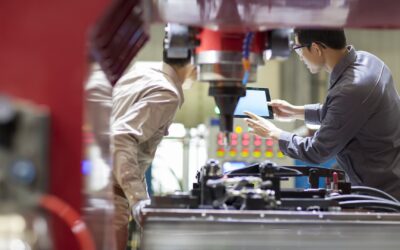The global manufacturing sector has faced plenty of headwinds over the past couple years. Despite a rather dismal outlook at the start of the COVID-19 pandemic, things seem to be finally picking up. With the passing of policy initiatives like the CHIPS Act and Inflation Reduction Act, belief in a long-term recovery is strong. So much so, that Deloitte projects 2.5% growth in manufacturing GDP for 2023.
However, while the predictions of industry experts are promising, they don’t negate the fact that we still have a long way to go in getting there. This year will prove to be a pivotal time for the manufacturing sector — one that tests its ability to remain agile and grow in the face of change. This article takes a look at five key trends to prepare for in 2023.
1. Investment In New Technology
As industries advance, businesses are given the option to either evolve or stagnate. The former is obviously the most popular choice, but isn’t without serious commitment. Manufacturers that want to stay afloat and mitigate their risks of falling behind in the future know that they should be investing in new technologies now. The strategy has worked well in the past, and as we head into an uncertain 12 to 18 months ahead, it will be invaluable to maintaining the key dynamics needed to survive.
According to Deloitte’s 2023 manufacturing outlook survey, large companies plan on investing in a range of technologies this coming new year. Among the most prevalent are Robotics and automation (62%), Data analytics (60%), and Internet of Things (loT) platforms (39%), a sure sign of the increasing move to Industry 4.0.
2. New Talent Management Strategies
The manufacturing sector, like many other industries, faced an upheaval of talent during COVID-19. Things have since recovered at a record pace, but unfortunately not fast enough to meet the growth of this booming industry. As it stands, unfilled manufacturing jobs are projected to hit 2.1 million by 2030, while turnover, career changes, and retirements exacerbate the problem further.
One in three manufacturers surveyed by Deloitte consider retention a top priority for 2023, a continuation of that status from 2022. Manufacturers know that there isn’t a future without staff, and as such, have begun adopting new talent management strategies to keep them on board. From retaining top staff and investing in the right people to competitive wages, career advancement opportunities, skill development, and more, the industry should expect to see more of these initiatives in the year to come.
3. Enhancing Supply Assurance
Both COVID-19 and recent global conflicts have shed light on something many of us have ignored for too long — the vulnerability of the U.S. supply chain. Recent data shows that at least 80% of manufacturers experienced either “heavy” to “very heavy” impacts of disruption over the last 12 to 18 months.
This has prompted many executives to begin focusing on the resilience of their operations and invest in supply assurance. Strategies vary from organization to organization, but often include the following.
Relationship Management
Strong relationships with multiple partners and suppliers enable manufacturers to effectively pivot in the face of unexpected change.
Building Supply Chain Redundancy
Just like how many strong partnerships can increase a company’s resilience, so too can a diversified network of suppliers. Organizations are now investing in multiple suppliers for the same products and services to minimize their risk of disruption.
Boosting Local Capacity
Companies across America continue to invest in domestic production and manufacturing to reduce their risks of overseas disruption. The recent passing of the Jobs Act, the CHIPS Act, and the IRA is expected to make this easier.
Implementing Digital Technologies
New technologies give manufacturers the efficiency and confidence they need to grow in an increasingly turbulent landscape.
4. Smart Factory Initiatives
As the full-fledged reality of Industry 4.0 only gets closer, manufacturers are only set to continue their investments in smart technology. Not only will doing so be essential to surviving as a business, but also remaining competitive within an increasingly dynamic landscape.
Those that want to get ahead in 2023 and beyond are laying their groundwork for success now by taking initiative with strategic investments. We have, and expect to see further adoption of cloud, edge computing, and 5G technology, as well as partnerships across the value chain. According to Deloitte’s recent survey, more than 60% of executives plan on partnering with specialized technology companies to further their smart factory initiatives.
5. A Focus On Corporate Social Responsibility
Quickly evolving Environmental, Social, and Governance (ESG) expectations have changed the playing field for every company out there, regardless of industry. However, manufacturers in particular face concentrated focus and scrutiny, as their operations are often cited as a top contributor to global challenges like climate change.
In 2023, manufacturers will continue striving for progress and visibility on their ESG commitments by operationalizing changes across the value chain. This will involve a range of initiatives, from improving energy efficiency and implementing more sustainable production processes to reducing waste and investing in employee safety.
Manufacturers should expect to see more regulatory pressures in the coming year, as well as an increased focus from investors on their ESG programs. To remain competitive, manufacturers must be proactive in their sustainability initiatives and have the data to prove it.
What does the future look like? Unfortunately, that isn’t something anyone can predict with certainty. But what we do know for now is that things are changing, and quickly. Like other times of industrial revolution in the past, it will be up to manufacturers that want to survive to face this challenge with agility and a readiness for new norms. Only then will they be prepared for 2023, 2024, and the countless years of innovation that await.
Sign up today for a free Essential Membership to Automation Alley to keep your finger on the pulse of digital transformation in Michigan and beyond.
Automation Alley is a World Economic Forum Advanced Manufacturing Hub (AMHUB) for North America and a nonprofit Industry 4.0 knowledge center with a global outlook and a regional focus. We facilitate public-private partnerships by connecting industry, education and government to fuel Michigan's economy.




